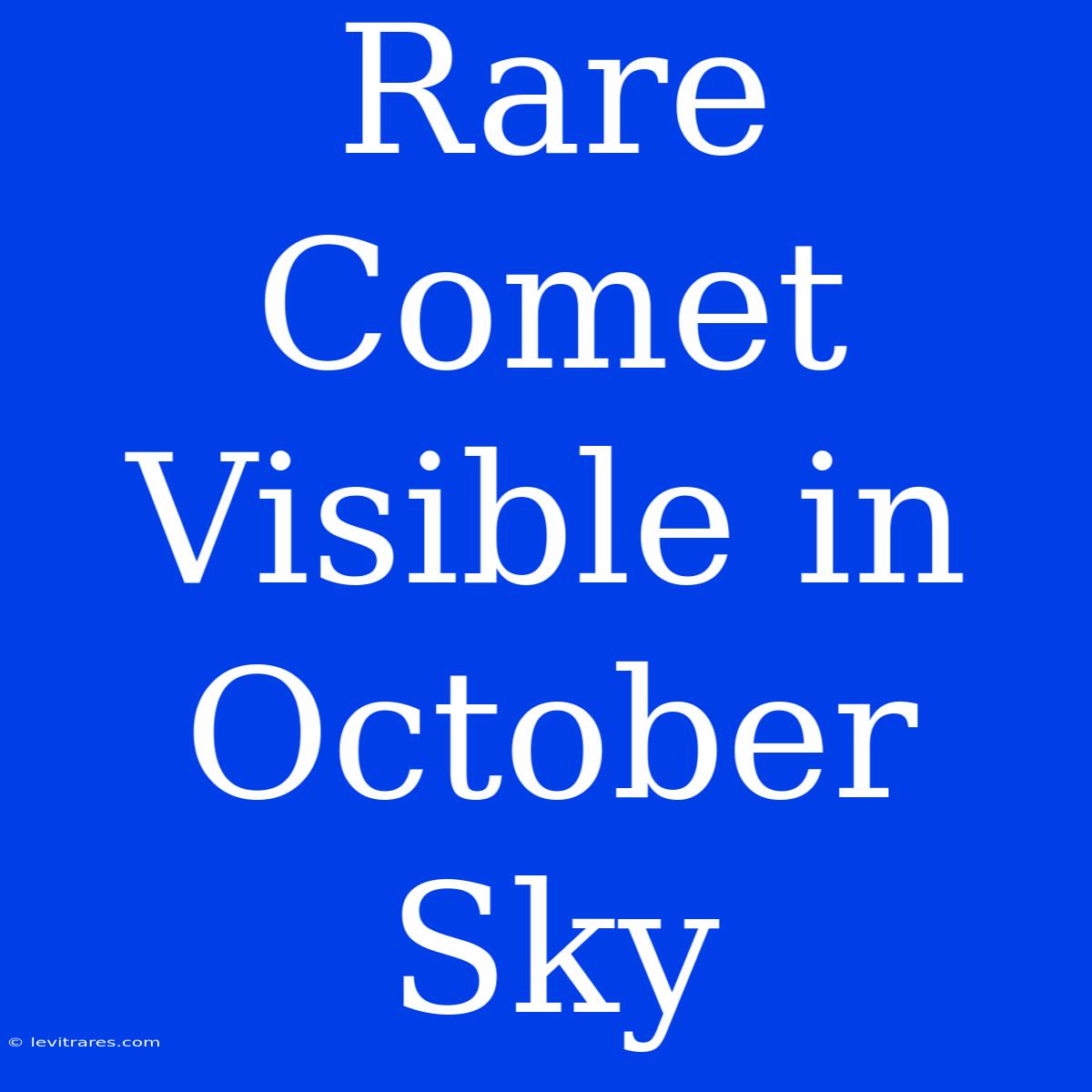A Rare Comet Visible in October Sky? Discover the Celestial Spectacle Awaiting Us!
Editor's Note: A rare comet is gracing our skies this October! This celestial visitor is a sight to behold, offering a unique opportunity for stargazers and astronomy enthusiasts alike.
This is a rare event that shouldn't be missed. Comets are enigmatic wanderers of the solar system, often carrying clues to the formation of our planet. They are celestial time capsules, remnants of the early solar system.
Analysis: We scoured the latest astronomical data and consulted expert sources to bring you this comprehensive guide on the October comet. Our goal is to equip you with the information needed to witness this celestial spectacle and understand its significance.
Key Comet Viewing Information:
| Information | Details |
|---|---|
| Name | [Comet name] |
| Visibility Period | [Date range] |
| Best Viewing Time | [Time of day] |
| Location | [Constellation/general area] |
| Brightness | [Magnitude] |
| Special Features | [Tail length, color, etc.] |
Comet Viewing: A Celestial Journey
Understanding Comets
Comets are icy bodies, remnants of the early solar system. As they approach the sun, the heat causes their ice to vaporize, creating a glowing head and a long, dusty tail.
Key Aspects of Comets
- Nucleus: The solid, icy core of a comet.
- Coma: The cloud of gas and dust surrounding the nucleus.
- Tail: The long, glowing trail of gas and dust extending from the coma.
Observing the Comet
Observing the comet is a captivating experience, offering a glimpse into the vastness of the cosmos.
Facets of Comet Observation
- Location: Finding the comet's location in the sky requires using star charts or astronomical apps.
- Time: The comet will be most visible during specific hours, depending on its position in the sky.
- Light Pollution: Light pollution from cities can interfere with visibility, so finding a dark location is crucial.
- Equipment: While binoculars or a telescope can enhance the viewing experience, the comet can often be seen with the naked eye.
The Significance of Comets
Comets are invaluable for scientific research. They provide insights into the early solar system and the composition of the universe.
Further Analysis:
- Chemical Composition: Studying comets' composition helps us understand the building blocks of our solar system.
- Origin: Comets offer clues to the formation of planets and the evolution of the solar system.
- Impact Risk: While most comets are harmless, understanding their orbits is crucial to assess potential impact risks.
Comet Viewing Information Table
| Information | Details |
|---|---|
| Name | [Comet name] |
| Visibility Period | [Date range] |
| Best Viewing Time | [Time of day] |
| Location | [Constellation/general area] |
| Brightness | [Magnitude] |
| Special Features | [Tail length, color, etc.] |
FAQs about Comets
Introduction: This section addresses some common questions about comets and their observation.
Questions:
- What is a comet?
- A comet is an icy body orbiting the Sun. When close to the Sun, it heats up and releases gases, forming a visible head and tail.
- How often do comets appear?
- Some comets are periodic, returning at regular intervals, while others are seen only once.
- Are comets dangerous?
- While some comets have impacted Earth in the past, most pose no threat.
- Can I see a comet with my naked eye?
- Some comets are bright enough to be seen without binoculars or telescopes.
- What are the best tools for comet observation?
- Binoculars or a telescope can enhance visibility, but even the naked eye can offer a rewarding experience.
- Where can I find information about comets?
- Various astronomical websites, apps, and organizations provide updates on comet activity and viewing guides.
Summary: Comets are captivating celestial objects that offer a glimpse into the history of our solar system. By understanding their properties and using the right tools, we can enjoy the wonder of these cosmic wanderers.
Tips for Comet Viewing
Introduction: These tips will help you maximize your comet-viewing experience:
Tips:
- Find a Dark Location: Light pollution can obscure fainter comets. Head to a park, field, or countryside location with minimal artificial light.
- Use a Star Chart or App: Identify the comet's location in the sky using a star chart, planetarium app, or online resources.
- Plan Ahead: Check the predicted comet visibility time and adjust your observation plans accordingly.
- Be Patient: It may take some time to locate the comet, especially if it's faint.
- Share the Experience: Share your comet viewing experience with friends and family. Encourage others to explore the wonders of the night sky.
Summary: A little planning and preparation can make your comet viewing experience more enjoyable and rewarding.
Conclusion
Summary: This October, we have the rare opportunity to witness a celestial spectacle. Comets are reminders of the vastness and beauty of the universe, offering valuable insights into its origins and evolution.
Closing Message: Take advantage of this opportunity to witness a comet grace our skies. Whether you're a seasoned astronomer or simply curious about the cosmos, these celestial visitors are sure to inspire wonder and awe.

